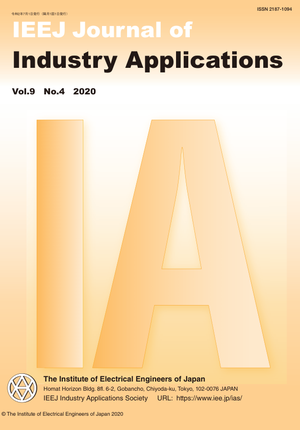A Novel Particle Jump Particle Swarm Optimization Method for PV MPPT Control under Partial Shading Conditions
A Novel Particle Jump Particle Swarm Optimization Method for PV MPPT Control under Partial Shading Conditions
カテゴリ: 論文誌(論文単位)
グループ名: 【D】産業応用部門(英文)
発行日: 2020/07/01
タイトル(英語): A Novel Particle Jump Particle Swarm Optimization Method for PV MPPT Control under Partial Shading Conditions
著者名: Bingcheng Ji (Department of Advanced Energy, Graduate School of Frontier Sciences, University of Tokyo), Katsuhiro Hata (Department of Informatics and Electronics, Institute of Industrial Science, University of Tokyo), Takehiro Imura (Department of Electr
著者名(英語): Bingcheng Ji (Department of Advanced Energy, Graduate School of Frontier Sciences, University of Tokyo), Katsuhiro Hata (Department of Informatics and Electronics, Institute of Industrial Science, University of Tokyo), Takehiro Imura (Department of Electrical Engineering, Tokyo University of Scienc), Yoichi Hori (Department of Advanced Energy, Graduate School of Frontier Sciences, University of Tokyo), Sayuri Honda (Reseach Unit I, R&D Directorate, Japan Aerospace Exploration Agency), Shuhei Shimada (Reseach Unit I, R&D Directorate, Japan Aerospace Exploration Agency), Osamu Kawasaki (Reseach Unit I, R&D Directorate, Japan Aerospace Exploration Agency)
キーワード: particle swarm optimization,global maximum power point tracking,particle jump,photovoltaic,simulated annealing
要約(英語): With the sharp increase in the global energy demands, photovoltaics (PV) have been developed significantly in recent years. However, when the PV work under partial shading conditions, the global maximum power point tracking control should be executed. In this paper, a novel particle swarm optimization (PSO) algorithm with the particle jump improvement is proposed to track the global maximum (GM) of PV output power under partial shading conditions. In the proposed method, each particle is allocated within respective intervals at initial iteration suh that the particle only explores the corresponding interval to determine the potential GM. When the corresponding interval has been traversed without determining the GM, the interval will be discarded and the particle will jump to the interval where the current tracked GM is present. Therefore, each interval of the converter duty range will be traversed by only one particle and the total algorithm tracking time will be reduced. The proposed algorithm is verified with a simulation and an experiment. Based on the experimental results, the tracking times of the proposed method are 0.8s, 0.8s, and 1.2s when the PV output power possesses 2, 3, and 4 peaks under partial shading conditions, respectively.
本誌: IEEJ Journal of Industry Applications Vol.9 No.4 (2020)
本誌掲載ページ: 435-443 p
原稿種別: 論文/英語
電子版へのリンク: https://www.jstage.jst.go.jp/article/ieejjia/9/4/9_435/_article/-char/ja/
受取状況を読み込めませんでした


